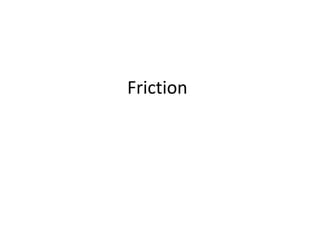
Friction Forces and Coefficients Explained
- 1. Friction
- 2. Outline • What is Friction? • Factors Affecting Friction • What Causes Friction? • Types of Friction • Application of Friction • Friction Problem with Solution
- 3. Friction • Friction is a force between two surfaces that are sliding, or trying to slide, across each other. Friction always slows a moving object down. The amount of friction depends on the materials from which the two surfaces are made. The rougher the surface, the more friction is produced. Friction also produces heat.
- 5. • Coefficient of friction, ratio of the frictional force resisting the motion of two surfaces in contact to the normal force pressing the two surfaces together. It is usually symbolized by the Greek letter mu (μ). Mathematically, μ = F/N, where F is the frictional force and N is the normal force. • Two types of friction coefficient are distinguished: the static friction coefficient and the kinetic friction coefficient. The former is sometimes called the starting friction coefficient, and the latter is sometimes called the dynamic or sliding friction coefficient.
- 6. • The coefficient of friction depends on the objects that are causing friction. The value is usually between 0 and 1 but can be greater than 1. A value of 0 means there is no friction at all between the objects; such is possible with Super fluidity. A value of 1 means the frictional force is equal to the normal force. • Coefficient of friction is the amount of friction existing between two surfaces. A low value of coefficient of friction means less force is required for sliding to occur. A higher value means more force is required.
- 7. Example • As an example, ice on steel has a low coefficient of friction – the two materials slide past each other easily – while rubber on pavement has a high coefficient of friction – the materials do not slide past each other easily. • Among all measured sites, the palm of the hand has the highest coefficient of friction (0.62±0.22). For all the materials tested, silicone has the highest coefficient of friction (0.61 ±0.21), while nylon has the lowest friction (0.37±0.09).
- 8. Frictional force causes a lot of losses in general upkeep and wear and tear of machinery. ... But almost all crucial tasks cannot be carried out without the presence of friction. Basic activities like walking and writing on a surface are possible due to friction. Hence it is considered as a necessary evil
- 9. Applications • Driving of a vehicle on a surface. • Applying brakes to stop a moving vehicle. • Skating. • Walking on the road. • Flying of aero planes. • Drilling a nail into wall. • Sliding on a garden slide.
- 10. • Friction finds application when matchsticks are ignited. • Motion of pistons in a cylinder is an application of friction. • It is possible to write on books and board as there is friction between pen and the board.
- 11. Increasing Friction • There are two methods of increasing friction: one is by making the surfaces rough and the other by increasing the mass of the object that is moving. For example, the tyres of vehicles have treads which increase the friction between the tyre and the road
- 12. Factors Affecting Friction 1. The nature of the two surfaces that are in contact Friction is dependent on the smoothness or roughness of the two surfaces that are in contact with each other. When the surface is smooth, the friction between the two reduces as there is not much interlocking of irregularities. While the surface is rough, friction increases. 2. The force that is acting on these surfaces Friction increases when the force is applied along with the irregularities.
- 13. Friction Advantages • Friction enables us to walk freely. • It helps to support ladder against wall. • It becomes possible to transfer one form of energy to another. • Objects can be piled up without slipping. • Breaks of vehicles work due to friction. Disadvantages • Friction produces a lot of heat in various parts of the machinery and this leads to wastage of energy as heat. • Opposes motion, hence more energy is needed to overcome friction. • Noise production in machines is irritating as well as leads to energy loss.
- 14. • Produce heat in moving parts of machines/engines. Produce noise in machines /engines. Makes engines to consume more fuel, in other words it reduces the efficiency of engines. Cause wear and tear in moving parts of machines/engines.
- 15. Types of Friction • Static Friction • Kinetic Friction • Rolling Friction • Sliding Friction • Fluid Friction
- 21. The laws of dry friction, coefficients of friction
- 22. • The coefficient of static friction is the ratio of the maximum static friction force (F) between the surfaces in contact before movement commences to the normal (N) force. • The coefficient of friction depends on the materials used; for example, ice on steel has a low coefficient of friction, while rubber on pavement has a high coefficient of friction.
- 23. Laws
- 24. Angles of friction • It is sometimes convenient to replace normal force “N”, and friction force “F” by their resultant “R”.
- 25. • Consider block of weight W resting on board with variable inclination angle ϴ
- 26. Friction Angles
- 28. Sample Problem
- 29. Solution
- 30. Wedges
- 31. Assignment • The position of the machine block B is adjusted by moving the wedge A. Knowing that the coefficient of the static friction is 0.35 between all surfaces of contact, determine; a) The force P required to raise the block B, b) To lower block B.
Editor's Notes
- Superfluidity is the characteristic property of a fluid with zero viscosity which therefore flows without any loss of kinetic energy.